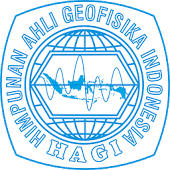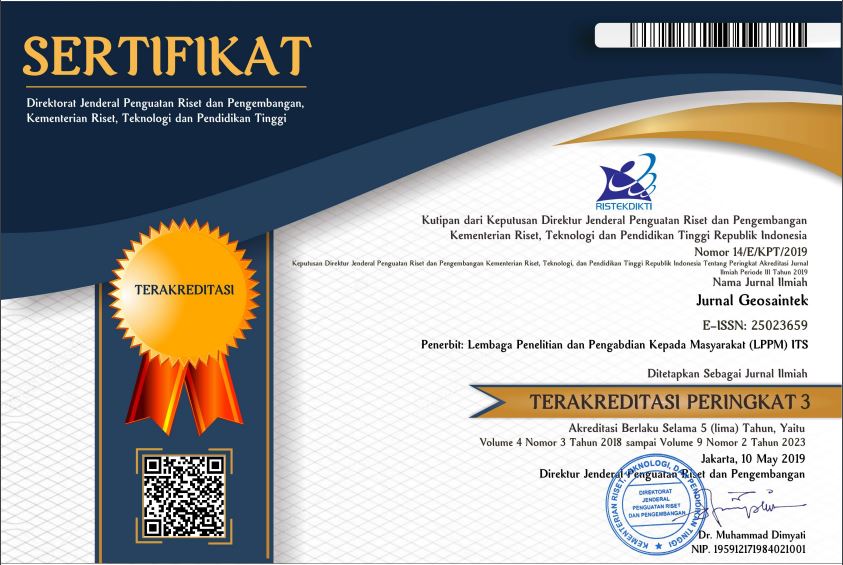SUSEPTIBILITAS MAGNETIK SISTEM PANASBUMI NON VULKANIK DESA TERAK MENGGUNAKAN METODE GEOMAGNETIK
Abstract
Geothermal in Bangka Belitung islands are classified as radiogenic type of non-volcanic geothermal. Geothermal in this area was formed due to granite rocks that have been fractured, folded or faulted. Geothemal Terak has a surface temperature of 550C - 61.80C with a water discharge of 0.2 liters/second. This research aims to identify the forming rocks of geothermal system at Terak village based on magnetic field anomalies. Data acquisition was measured using a Proton Precession Magnetometer (PPM) along 2.5 km with 100 m spacing and 500 m spacing between lines. Data processing was analyzed using diurnal correction, IGRF correction, RTE (Reduce to the Equator) correction, anomaly separation using Upward Continuation. Modeling performed by applying 2D Inverse Modeling. The results indicated that the reservoir rock in Terak area with non-volcanic geothermal system was granite with susceptibility 42 x 103 - 49 x 103. The depth of the reservoir rock was partially at a depth of 30 - 125 meters above sea level and some were exposed on the surface (0 - 80 meters above sea level). Reservoir rocks are scattered in the northwest area of the study.
Keywords
geothermal; non-volcanic; Terak; anomaly; magnetic;
Full Text:
PDFReferences
Afni, G.N. and Kusmita, T. (2021), “Identifikasi Struktur Tektonik Sistem Geothermal Non-Vulkanik Daerah Nyelanding dan Permis Bangka Selatan Menggunakan Metode Gravity”, JRFI, Vol. 2 No. 1, pp. 1–6.
Alawiyah, U. and Kusmita, T. (2022), “Sebaran Batuan Daerah Panas bumi Terak Bangka Tengah berdasarkan Anomali Magnetik”, Jurnal Riset Fisika Indonesia, Vol. 3 No. 1, pp. 12–18, doi: 10.33019/jrfi.v3i1.3356.
Al-Khafaji, W. (2021), Magnetic Geophysical Method Course Lectures for Undergraduate Students.
Anderson, D.N. and Lund, J.W. (1979), Direct Utilization of Geothermal Energy: A Technical Handbook, United States, doi: 10.2172/6707209.
Çağlar, I. and Demırörer, M. (1999), “Geothermal exploration using geoelectric methods in Kestanbol, Turkey”, Geothermics, Vol. 28 No. 6, pp. 803–819, doi: https://doi.org/10.1016/S0375-6505(99)00044-9.
EBTKE ESDM and Badan Geologi. (2017), Potensi Panas Bumi Indonesia Jilid 1 Penyusun.
Firdaus, R., Oktaviyani, S., Hardianti, P., Kusmita, T. and Indriawati, A. (2021), “Identification of Subsurface Rock Structure of Non-Volcanic Geothermal Systems Based on Gravity Anomalies (Terak Village, Central Bangka Regency)”, Journal Of Applied Geospatial Information, Vol. 5 No. 2, pp. 539–543.
Franto, F. (2015), “Interpretasi Struktur Geologi Regional Pulau Bangka Berdasarkan Citra Shuttle Radar Topography Mission (SRTM) (Interpretation Structure of Regional Geology on Bangka Island with Shuttle Radar Topography Mission (SRTM))”, Vol. 3, pp. 10–20.
Gusnia, E. and Kusmita, T. (2023), “Identifikasi Batuan Penyusun Sistem Panas Bumi Non-Vulkanik Bangka Tengah Berdasarkan Penampang 2d Anomali Gaya Berat”, Journal Online Of Physics, Vol. 8 No. 3, pp. 8–13, doi: 10.22437/jop.v8i3.27080.
Gusnia, E., Kusmita, T. and Indriawati, A. (2022), “Analisis Anomali Gravity Daerah Panas Bumi Non-Vulkanik Di Bangka Tengah (Studi Kasus Panas Bumi Terak dan Keretak)”, JRFI, Vol. 2 No. 2, pp. 1–7.
Kanakiya, S., Turner, G.M., Rowe, M.C., Adam, L. and Lindsay, J.M. (2021), “High Remanent Magnetization Measured in Hydrothermally Altered Lavas”, Geophysical Research Letters, John Wiley and Sons Inc, 16 December, doi: 10.1029/2021GL095732.
Kusmita, T., Adhyaksa, Y.A., Nasri, M. and Joni, W. (2022), “Resistivity analysis of geothermal system at cubadak village west sumatera using magnetoteluric method”, IOP Conference Series: Earth and Environmental Science, Vol. 1108, IOP Publishing, p. 12066, doi: 10.1088/1755-1315/1108/1/012066.
Kusmita, T., Fath, A.M. and Joni, W. (2020), “Magnetotelluric method aplication for conceptual modelling of geothermal system Pariangan West Sumatera”, IOP Conference Series: Earth and Environmental Science, Vol. 599, doi: 10.1088/1755-1315/599/1/012038.
Li, D., Liang, Q., Du, J., Sun, S., Zhang, Y. and Chen, C. (2020), “Transforming Total‐Field Magnetic Anomalies Into Three Components Using Dual‐Layer Equivalent Sources”, Geophysical Research Letters, Vol. 47 No. 3, doi: 10.1029/2019GL084607.
Li, X. (2007), “Magnetic Reduction-to-the-pole At Low Latitudes: Practical Considerations”, Vol. All Days.
LUO, Y., XUE, D.-J. and WANG, M. (2010), “Reduction to the Pole at the Geomagnetic Equator”, Chinese Journal of Geophysics, Vol. 53 No. 6, pp. 1082–1089, doi: 10.1002/cjg2.1578.
Manga, A. and Djamal, B. (1990), “Peta Geologi Lembar Bangka Utara, Sumatra”, Badan Geologi, Bandung.
Mariita, N.O. (2007), The Magnetic Method, Kenya.
Purwoto, E., Rezky, Y. and Simarmata, R. (2013), Survei Aliran Panas (Heat Flow) Daerah Panas Bumi Permis Kabupaten Bangka Selatan, Provinsi Bangka Belitung, Bandung.
Putri, B.D.A. and Harianja, A.K. (2021), “Identifikasi Prospek Panas Bumi Radiogenik Menggunakan Landsat-8 Dan Gravitasi Di Daerah Permis”, JGE (Jurnal Geofisika Eksplorasi), Vol. 7 No. 1, pp. 52–70, doi: 10.23960/jge.v7i1.115.
Soengkono, S. (2016), “Airborne Magnetic Surveys to Investigate High Temperature Geothermal Reservoirs”, in Ismail, B.I. (Ed.), Advances in Geothermal Energy, IntechOpen, Rijeka, doi: 10.5772/61651.
Stella, A. and David, F. (2015), “Regional Magnetic Field Trend and Depth to Magnetic Source Determination from Aeromagnetic Data of Maijuju Area, North Central, Nigeria”, Physical Science International Journal, Sciencedomain International, Vol. 8 No. 3, pp. 1–13, doi: 10.9734/psij/2015/21652.
Telford, W., Gerald, L. and Sheriff, R.E. (1990), Applied Geophysics, 2nd ed., Camridge University Press, United Kingdom.
William Lowrie. (2007), Fundamentals of Geophysics, 2nd ed., Cambridge University Press, Cambridge .
Yang, J., Liu, S. and Hu, X. (2020), “Inversion of high-amplitude magnetic total field anomaly: an application to the Mengku iron-ore deposit, northwest China”, Scientific Reports, Nature Research, Vol. 10 No. 1, doi: 10.1038/s41598-020-68494-1.
DOI: http://dx.doi.org/10.12962%2Fj25023659.v9i3.15563
Refbacks
- There are currently no refbacks.

Jurnal Geosaintek diterbitkan oleh ITS bekerja sama dengan Himpunan Ahli Geofisika Indonesia (HAGI)
Disebarluaskan di bawah Lisensi Creative Commons Atribusi-BerbagiSerupa 4.0 Internasional.
Berdasarkan ciptaan pada https://iptek.its.ac.id/index.php/geosaintek/index.





